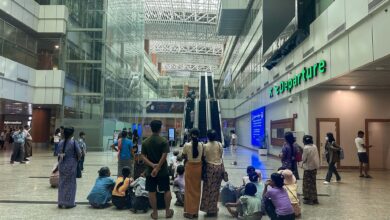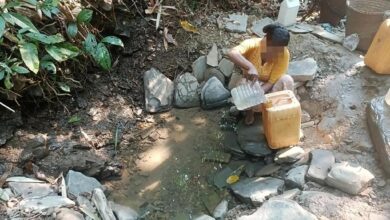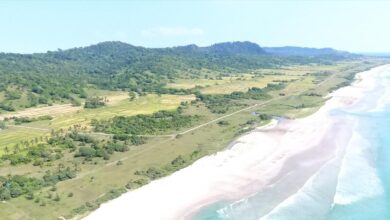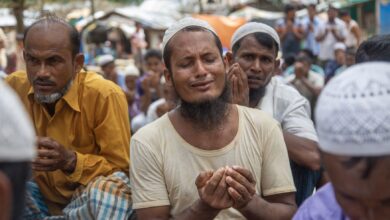
On the night of October 23, as the Kachin Independence Organisation (KIO) was celebrating the 62nd anniversary of its founding with a music festival in Kachin State’s Hpakant Township, Myanmar’s military carried out its deadliest air raid since seizing power in February 2021.
According to the KIO, three fighter jets were deployed in the assault, which killed at least 60 people, including senior leaders of the group and its armed wing, the Kachin Independence Army (KIA). The ultimate death toll, however, was much higher, as military interference on the ground prevented many of the wounded from receiving the immediate medical attention they needed to survive.
“The total number of casualties, including both dead and injured, was 161,” said a local rescue worker. “There were many more dead—at least 100—because they weren’t able to get help in time to save them.”
Among those killed in the attack on A Nang Pa, the site of the festival that turned into a scene of carnage, were Col. Shraw Lasai, the commander of the KIA’s Brigade 9, which controls territory in Hpakant Township, and Col. Laphai La Aung, the person in charge of the ethnic armed group’s gem-mining operations in Hpakant.
It’s no mystery why the military decided to carry out this horrendous attack. The two sides have been fighting for more than a decade, and after the coup, the KIA became a major backer of anti-regime forces in northern Myanmar, including Kachin State, northern Shan State, and Sagaing Region. Moreover, the two armed forces both have major interests in Hpakant’s lucrative gems industry.
Although Hpakant has seen occasional clashes between the KIA and junta forces since the military takeover nearly two years ago, it was not a major conflict hotspot before October 23. Now that it has become one, the situation remains tense and potentially volatile, according to locals.

Divided control
Some 150 km east of the town of Hpakant, in the state capital Myitkyina, where the military’s Northern Regional Command headquarters is located, mechanized infantry units have gathered in preparation for battle, sources there have reported. And in the immediate area, at least 10 army camps have been set up at strategic locations.
“The military has taken up position on every mountaintop. They have occupied San Kywe Payagone, Mashi Ka Htaung near the entrance to Hpakant, Rakine Kone, and the Myo Oo stupa,” said a local man familiar with the situation.
There are also five junta bases located near Kansi, a village about 25 km northeast of Hpakant, and more near Sai Taung, another village southwest of the town, he added.
Meanwhile, KIA Brigade 9 also has at least five bases in the area, and several columns of troops spread out across the township. And like the military, which has tightened security since the air raids, it has imposed a curfew on the local population.
As both sides vie for control, their actual authority has been divided along urban/rural lines, with the junta dominant in the town of Hpakant and the KIA governing the villages through handpicked headman known as Salan Kabar.
In the weeks and months since October 23, a number of incidents have occurred against this background. In early November, several junta soldiers were injured when their base in the Seik Mu village tract, south of Hpakant, was attacked with heavy artillery, while later the same day, a number of policemen were injured when a bomb went off near a branch of the Myanma Economic Bank in Hpakant’s Maw Wan Ward.
On November 13, a number of KIA officers were captured by the military in Myitkyina, and four days later, three junta troops, including an army captain, were shot in Hpakant. Two died and one was captured in that attack, and on the following day, five officers were killed and three were injured during an assault that took place at a karaoke bar in Hpakant’s Hmaw Si Sar ward.
Meanwhile, military operations were also taking place. On November 15, a column of around 100 regime soldiers attacked local defence forces in the area between Hpakant and Mohnyin to the south. Although the KIA and its People’s Defence Force (PDF) allies helped to repel the attack, a number of local resistance fighters were forced to surrender.
Eight days later, a junta column was hit by explosives near the villages of Kaung San and Taung Kot, west of Sai Taung. One Taung Kot villager was killed when the military retaliated by firing heavy artillery, and several others were taken into custody.

Economic impact
Even before the air raid on A Nang Pa, the military was putting pressure on Hpakant by preventing traders from bringing food, fuel and medical supplies into the township. This started just days before the attack, and continues to cause hardships for local people.
Prices have skyrocketed. Gasoline now costs 20,000 kyat ($9.50) a gallon in Hpakant, and most other prices—for everything from rice to hypertension medication—have at least doubled, according to residents.
A large bag of rice that was just 60,000 kyat ($28.50) just over two months ago is now 130,000 kyat (more than $60), according to a local woman.
“The price of rice started going up gradually about three months ago, but then it really shot up. Prices have been through the roof since the air raid, partly because that’s when people started buying it in large quantities,” said the woman, who did not want to be named.
The same was also true of cheaper items, such as the blood-pressure drug sold under the brand name Amlong, which previously cost just 1,000 kyat ($0.50) for a strip of 10 tablets. Customers must now pay twice as much for the same quantity, residents told Myanmar Now.

As a town that attracts fortune-seekers from all over the country, Hpakant is also known for its vibrant nightlife. Now, however, the streets are deserted by 8pm, according to a 30-year-old migrant worker who attributed the change to security concerns.
“The KIA has issued a statement. I think they will retaliate. I don’t know how long the fighting will last. Everyone is anxious about the whole situation,” he said.
Internet access has also become costly, with some residents saying that the current situation is reminiscent of the early 2000s, when the previous regime made the internet so prohibitively expensive that few people could actually use it. In August of last year, the junta moved to disconnect Hpakant completely, although some places in the town still use devices leased from telecoms provider Ooredoo for satellite service.
“It comes with a small satellite dish about 1.5 feet in diameter that costs 3m kyat [$1,400]. The monthly fee is 500,000 kyat [$240] for 5 Mbps and double that for 10 Mbps,” said one local, who added that internet cafes that use this service charge between 3,000 and 5,000 kyat ($1.40-2.40) per hour.
Tangled ties
Hpakant’s primary industry, jade mining, has also been hit by the conflict. Controlled by the military and various ethnic armed groups, the mines only briefly suspended operations in the wake of the A Nang Pa air raid. But they have also greatly reduced their activity, according to a local who buys and sells scrap pieces of jade from scavengers who work the mines’ massive slag heaps.
“It’s all because of the fighting and politics,” he said. “They’re suffering heavy losses, so they only mine in a small area, and at a slow pace.”

Most of the mining companies in Hpakant have at least three sites, and under normal circumstances, you would see thousands of mini loaders at work extracting the ore. Now, however, the companies have laid off around two-thirds of their workforce, according to the scrap jade vendor.
In the immediate aftermath of the coup, the mines continued to operate as usual. Neither the KIA nor the military-owned Myanmar Economic Corporation (MEC), the two biggest players in Hpakant, wanted to disrupt this lucrative income stream, according to Moe Moe Tun, the executive director of Citizen Action for Transparency. She added that she expected this to continue.
“The KIA won’t block MEC’s mines because of military tensions. They don’t bother each other. I think they have a mutual understanding to mind their own business and not cross the line,” she said.
In June of last year, the UK-based monitor group Global Witness released a report titled “Jade and Conflict: Myanmar’s Vicious Circle,” which detailed how the overthrow of the previous civilian government had upended its efforts to increase oversight of Hpakant’s mining industry.
Even before the coup, it said, the military was “at the centre of a vicious cycle whereby conflict enables illicit resource extraction and opportunities for corruption and abuse of power, which in turn fuel further conflict.”
“The increase in fighting after the coup will only amplify these dynamics further,” it added.

According to Aung Hein Min, an MP from the ousted ruling party, the National League for Democracy, who represented Hpakant before the military takeover, the junta launched the October attack because it felt it was losing too much revenue.
“The military thinks their profits have decreased, so they retaliated with military operations. They would remain quiet if they were earning more,” said the 25-year-old MP, who has been working with the shadow National Unity Government since fleeing to a liberated area after the coup.
Military and political analyst Than Soe Naing noted, however, that while the regime has moved to bolster its military presence in the Hpakant region in a bid to protect its interests there, both sides will be forced to continue their uneasy coexistence due to their tangled business dealings.
“Neither side wants to shut down or suspend its businesses. That’s how the interests of both sides are maintained amidst the conflict,” he said.
The fact that the military released a number of KIA officers from prison weeks after it carried out a devastating assault on the group points to the complex nature of its relationship with ethnic armed organisations, he added.
Bracing for battle
As the military strengthens its position in Hpakant, the KIA is also digging in and preparing to launch new offensives, according to Than Soe Naing.
“Stricter regional control, followed by operations to take over junta military bases, can be expected, depending on the military situation,” he said. He added, however, that it would be impossible at this stage for the KIA to eradicate the military council’s battalions and create a liberated zone.
Aung Hein Min also anticipated more clashes, although he said they would likely take place in areas removed from Hpakant’s commercial centres.
“I’m sure the situation in the town and the villages won’t be too bad. It will be worse in the jungle and areas where military camps and headquarters are located,” he said.
According to locals, the area near the village of Kansi, located northeast of the town of Hpakant on the Uru River, is a potential flashpoint, as there are troops from both sides currently stationed there.
When the military seized power nearly two years ago, the KIA moved aggressively to take back territory it had lost in the preceding years. Fighting further intensified after the KIA started backing the anti-regime resistance by training and arming members of the nascent People’s Defence Force, particularly in neighbouring Sagaing Region.
Now that the military has demonstrated the extent to which it is willing to go to reassert its position in Myanmar’s north, Hpakant and other contested territories are on high alert.
“The military tension has substantially increased,” said KIO information officer Col. Naw Bu of the current situation in Hpakant.
While he didn’t make any predictions about what the coming months would bring, he noted that the military has tightened control over the town and restricted access to mines.
“Clashes also happen frequently,” he added, suggesting that more would likely be in store for the region as the conflict drags on, with no end in sight.



